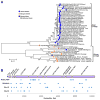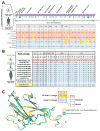From Mosquitos to Humans: Genetic Evolution of Zika Virus
- PMID: 27091703
- PMCID: PMC5648540
- DOI: 10.1016/j.chom.2016.04.006
From Mosquitos to Humans: Genetic Evolution of Zika Virus
Abstract
Initially isolated in 1947, Zika virus (ZIKV) has recently emerged as a significant public health concern. Sequence analysis of all 41 known ZIKV RNA open reading frames to date indicates that ZIKV has undergone significant changes in both protein and nucleotide sequences during the past half century.
Copyright © 2016 Elsevier Inc. All rights reserved.
Figures


References
-
- Broutet N, Krauer F, Riesen M, Khalakdina A, Almiron M, Aldighieri S, Espinal M, Low N, Dye C. Zika Virus as a Cause of Neurologic Disorders. N Engl J Med 2016 - PubMed
-
- Calvet G, Aguiar RS, Melo AS, Sampaio SA, de Filippis I, Fabri A, Araujo ES, de Sequeira PC, de Mendonca MC, de Oliveira L, et al. Detection and sequencing of Zika virus from amniotic fluid of fetuses with microcephaly in Brazil: a case study. Lancet Infect Dis 2016 - PubMed
-
- Duffy MR, Chen TH, Hancock WT, Powers AM, Kool JL, Lanciotti RS, Pretrick M, Marfel M, Holzbauer S, Dubray C, et al. Zika virus outbreak on Yap Island, Federated States of Micronesia. N Engl J Med. 2009;360:2536–2543. - PubMed
MeSH terms
Substances
Grants and funding
LinkOut - more resources
Full Text Sources
Other Literature Sources
Medical
Miscellaneous

